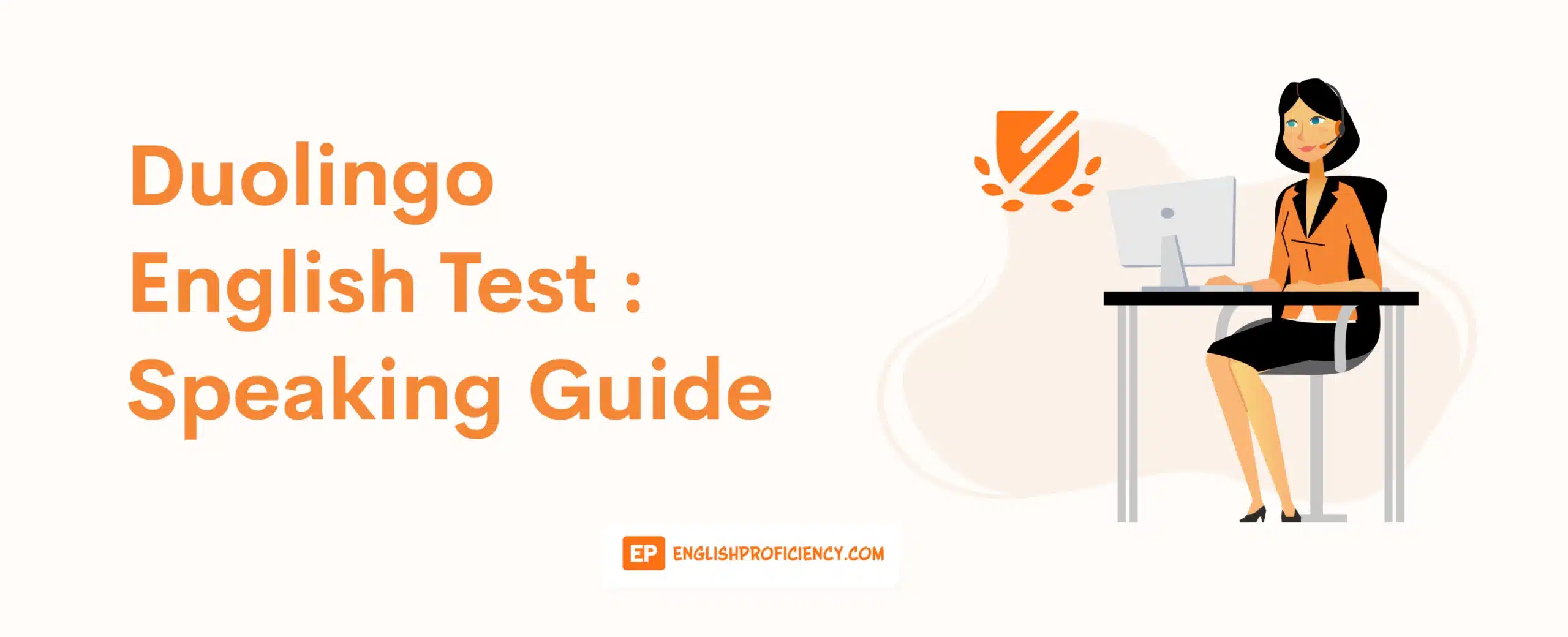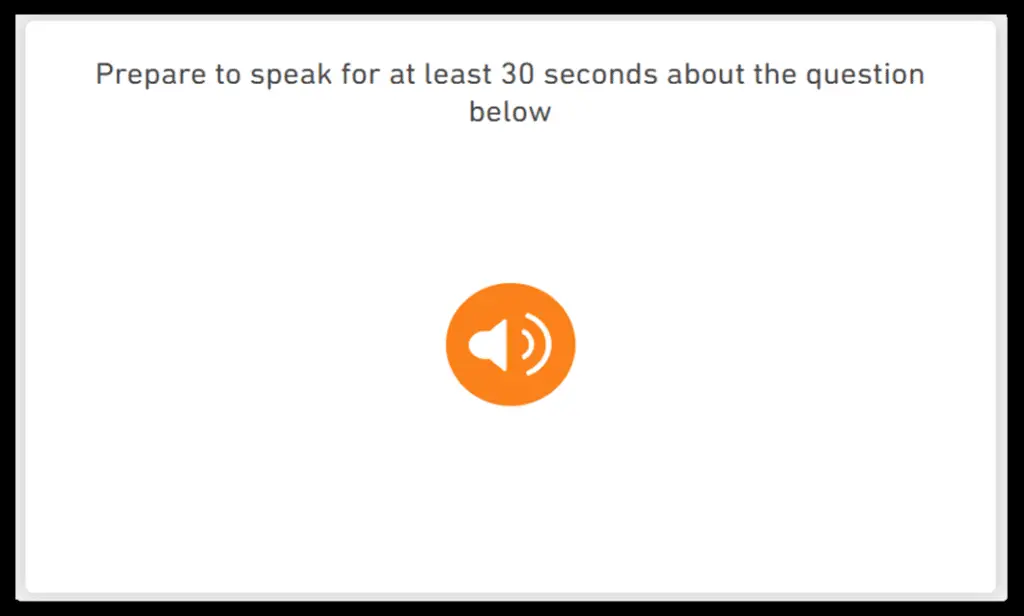The Duolingo English Test will ask you to complete various tasks to assess your speaking, reading, and listening abilities. This article will aid you with everything you need to prepare for the sections of the Duolingo English Speaking Test. This guide also includes sample and practice questions.
- Brief Overview of the Duolingo English Test
- What are all the Speaking Question Types on the Duolingo English Test?
- What is the Production Scoring and Subscoring Criteria for the DET?
- How to Properly Answer the “Speak About a Topic” Question?
- How to Properly Answer the “Read Aloud” Question Type?
- How to Answer the “Speak About the Photo” Question Type?
- How to Answer the “Speaking Sample” Question Type?
- Sample Practice Questions for the Speaking Section of the DET
- Additional Tips for the Taking Duolingo English Test Speaking Section
- Additional FAQ About the Duolingo English Test
Brief Overview of the Duolingo English Test
The Duolingo English Test is a unique English proficiency exam that assesses literacy, drawing, reading comprehension, and productivity. It’s a computer-based assessment that ranges from 10 to 160 points. Compared to other English proficiency exams such as the IELTS exam and the TOEFL test, the exams are just one hour long and extremely cheap (only USD 49).
The primary aim is to assess your English abilities and decide whether or not you are ready to attend university. Duolingo’s English test scores are good for two years. Over 1500 schools in the United States, the United Kingdom, Canada, and Australia have authorized them.
Duolingo’s English Exam, like other examinations, assesses your ability to communicate in English in real-life scenarios. Unlike IELTS and TOEFL, it does not have four sections for each ability. Instead, it will ask you a series of questions to assess your proficiency. It uses an adaptive system that adjusts to your response; the more accurate answers you make, the more complex the questions you will have.
What are all the Speaking Question Types on the Duolingo English Test?
According to Cushing-Weigle, 2002, independent tasks require students to make an argument or describe something, demonstrating more discursive knowledge of writing and their language skills.
What exactly do you have to do? Let’s have a quick overview of the different types of speaking tasks:
- One picture description task
- Three independent speaking tasks
- Two with written prompts
- One with aural (listening) prompts
Below are the different question types that utilize these tasks:
1. Speak About the Photo
Instead of writing about the picture, the test will require you to talk about it in the Speak About the Photo section.
Before going to the recording screen, the Duolingo English Test will prompt you with the question and photo for 20 seconds. You may manually progress through the rest of the questions. People, animals, buildings, events, and nature are all possible subjects for this test format.
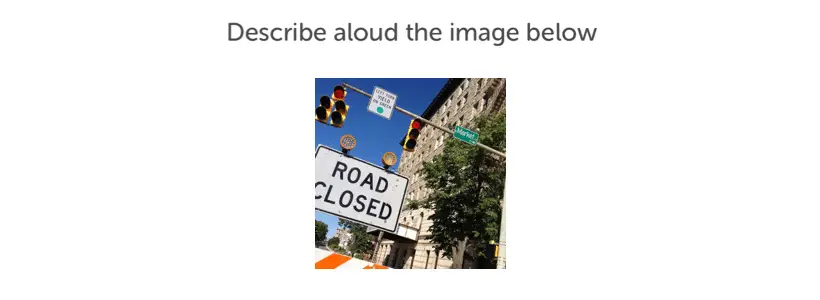
2. Read Aloud
In the Read Aloud section, you will read a printed prompt and speak or submit your response for at least 30 seconds. You have 20 seconds to prepare before the countdown begins, and the question’s instructions will appear.
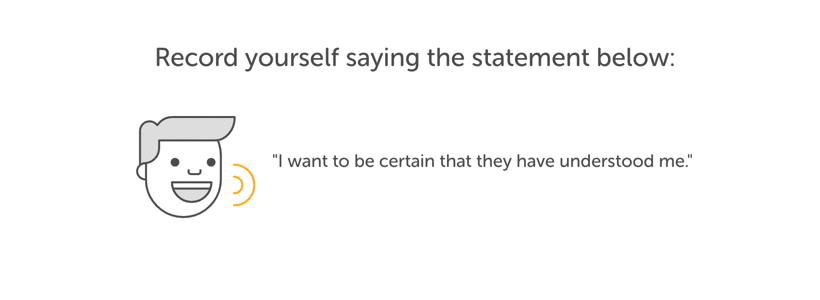
3. Listen, then Speak
In the Listen, then Speak section, you will be required to listen to the spoken prompt and speak out their response, similar to the question type above.
Before immediately moving to the recording screen, candidates will have 20 seconds to listen to and repeat the question.
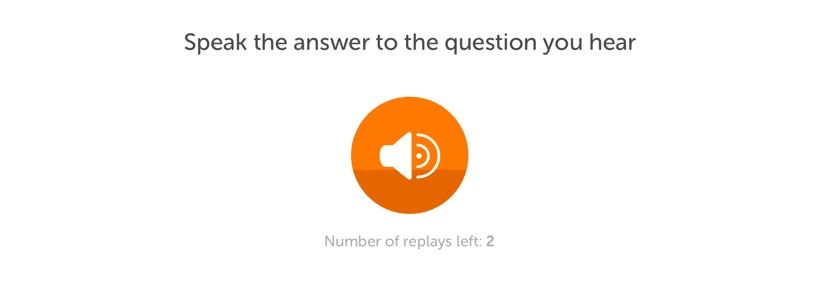
4. Read Aloud
in the Read Aloud section, a phrase will appear on the screen in this section.
It would be best if you videotaped yourself speaking the words. This question type evaluates your ability to communicate.

5. Speaking Sample
You must choose one of the two prompts shown on the screen to complete the Speaking Sample section of the ungraded portion of the Duolingo English Test.
You must provide a detailed presentation for 1 to 3 minutes on one of the subjects.
You must read, evaluate, and choose one of the two options provided since the instructions will display for 30 seconds before the recording begins.
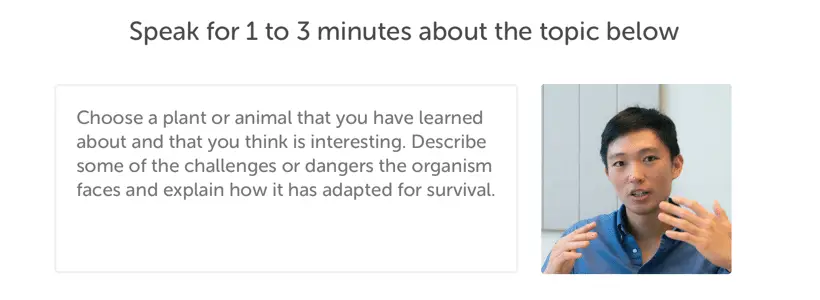
What is the Production Scoring and Subscoring Criteria for the DET?
The Adaptive Test is the only graded part of the Duolingo English Test. The various question types will be scored differently based on your answers.
The DET will automatically evaluate questions like the Read Aloud section by utilizing specific systems/procedures created only for such questions. The system will compare your responses to those of the correct answers and evaluate the differences and similarities.
The DET will not penalize you for submitting an incorrect or incomplete response. Half-accurate answers may even get candidates partial credit!
If you fail to answer a question, you may lose points more than when you respond incorrectly. So, you should answer every question.
The integrated grading system will evaluate open-response questions, including Speak About the Photo, Read and Speak, and Listen and Speak sections. Here, the goal is to understand and assess your English proficiency just like an expert examiner would.
The Duolingo English Test will evaluate your grammatical accuracy, complexity, vocabulary level, lexical diversity, and ability to communicate effectively in English.
-
Check out this guide from Duolingo about Subscores: Improving how we report Duolingo English Test results
-
To understand more about how the scores work, check out our detailed Duolingo English Test Scoring Guide
How to Properly Answer the “Speak About a Topic” Question?
Answer the questions by speaking. You must answer the question for 30 seconds. Correctly answer all questions as they will be recorded.
a. Written Prompt
- This question will appear twice.
- You will have 20 seconds to prepare mentally.
- You will then speak for 90 seconds on the topic.
- Speak for as long as possible.
- Topics: work, art, animals, people, hobby, etc.
- It contributes to your production and conversation subscores.
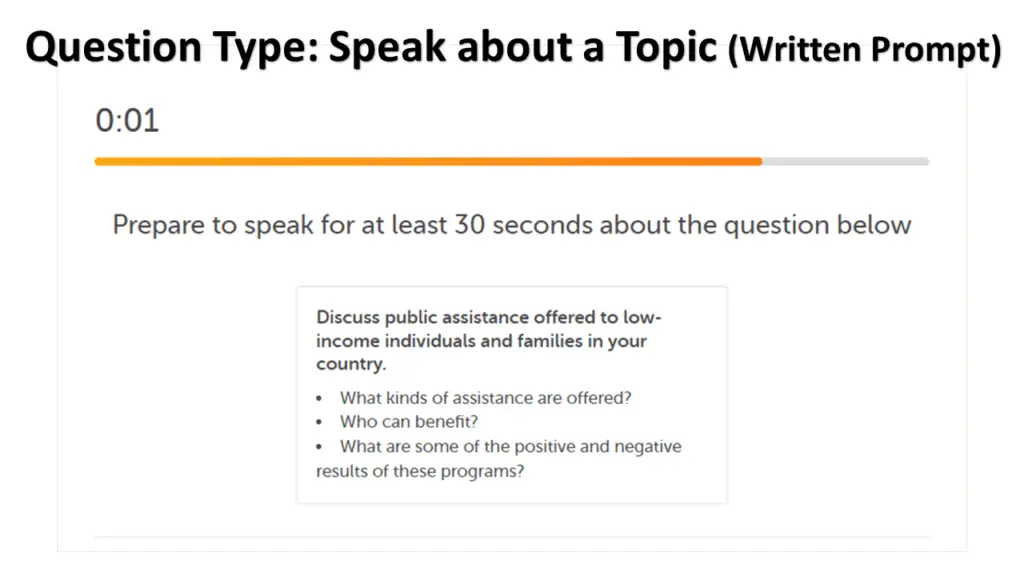
b. Aural Prompt
- This question will appear once.
- You will have 20 seconds to prepare mentally.
- You will then speak for 90 seconds on the topic.
- Speak for as long as possible.
- You can replay the question up to 3x
- Topics: work, art, animals, people, hobby, etc.
- It contributes to your production and conversation subscores.
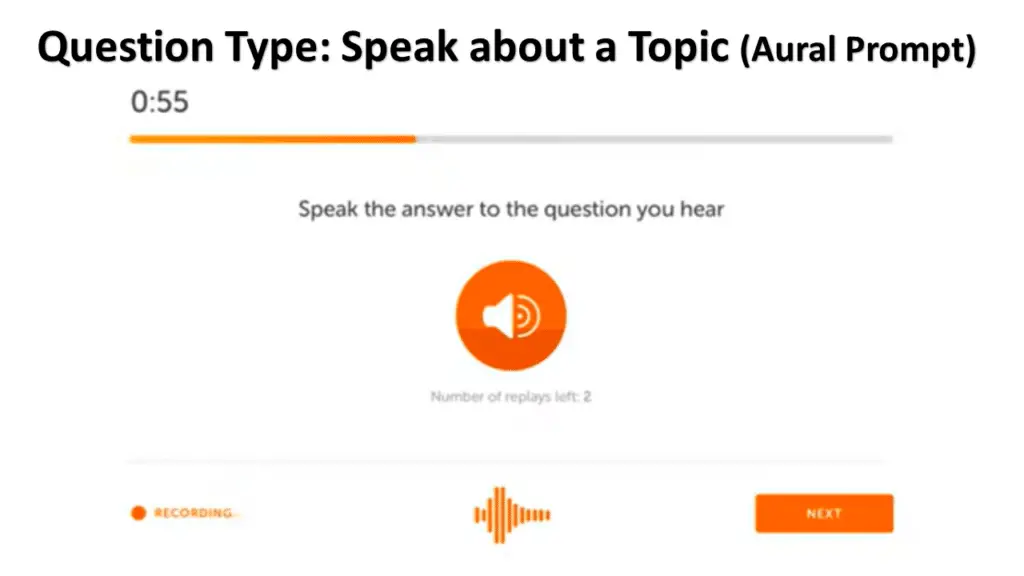
Tips for Answering These Questions:
- Answer the prompts: As with all previous speaking questions in this area, speak confidently, slowly, and clearly. Make sure that you have addressed all aspects of the question. Before going to the recording screen, organize and prepare your answer.
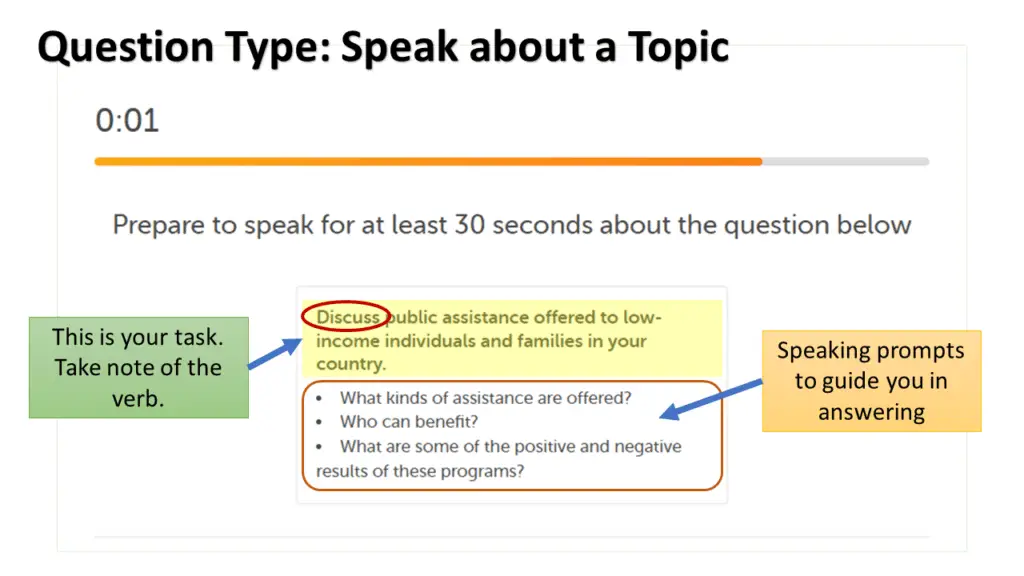
How to Understand and Answer Question Prompts?
Here are a few tips to keep in mind, that will aid you to properly answering question prompts.
- Discuss: examines the different arguments for and against a claim or a subject from various angles. It’s more than just stating facts or explaining things. It’s like evaluating, but you will not choose a side. You must utilize background knowledge to support your argument or subject.
- Describe: The prompt ‘describe’ is most comparable to ‘explain’; the only difference is purpose in some cases. In the Duolingo English Test, this prompt commonly appears using the word ‘Talk.’ Offer descriptions to make it more understandable.
- Answer and expand. Show that you are fluent.
Use the SEE Strategy to Answer Question Prompts:
S
State it
Describe it in one or two sentences.
In Manila, Philippines, low-income individuals and families get public assistance in cash or in-kind benefits from the local government.
E
Elaborate
Explain it in your terms.
Some of the assistance are Social Amelioration Program (SAP) and Pantawid Pamilyang Pilipino Program (4Ps). This assistance aims to aid families or individuals who cannot support themselves.
E
Exemplify
Give instances and counter-examples of the idea.
For instance, low-income families could sustain themselves during the first nationwide lockdown brought by this pandemic.
Use transition words: These words will help you to sound more fluent and more coherent, and there are lots of transition words you can use. If you want to move on to the following questions that will help you go on from one question to the next:
… turning to the next question… … moving on to question two… … as for questions one/two/three...
| Function | Transition Words |
|---|---|
| Additive words demonstrate the author’s point of view. | and, but, likewise, in addition to, moreover, for example, furthermore |
| Sequencing words display the chronological order of events. | firstly, secondly, next, then, finally, afterward, first, second, third |
| Cause and effect words show causal relationships. | as a result, consequently, because, since, due to, for, owing to |
| Compare and Contrast terms used to a new viewpoint, a change, or even a dispute. | different, similar to, similarly, unlike, in comparison, as well as, both, however, although, even though, in contrast to |
Sample Answer for this Question Type
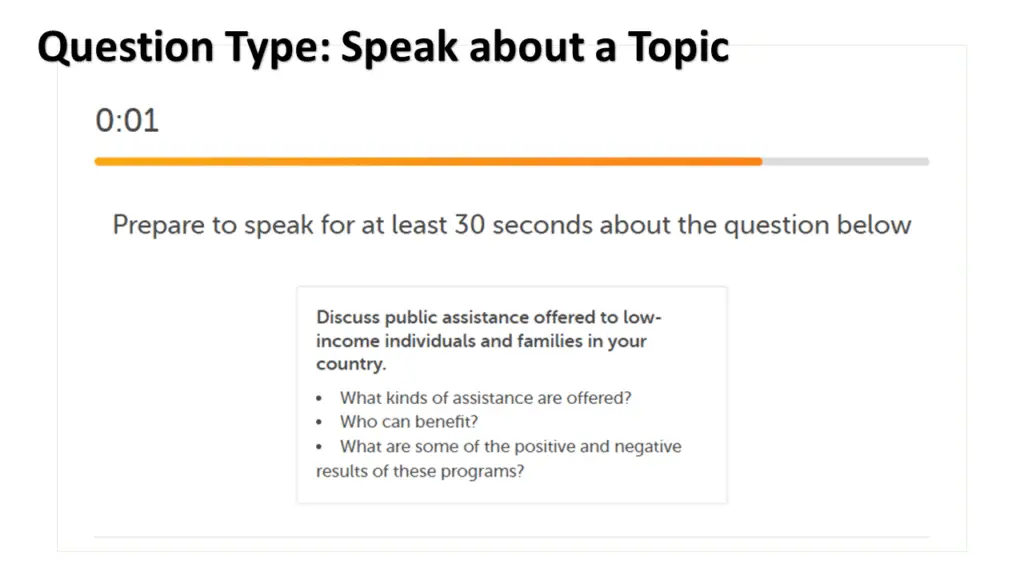
For this model answer, we will use the SEE Strategy to show you how to organize your thoughts while expounding your responses:
In Manila, Philippines, low-income individuals and families get public assistance in cash or in-kind benefits from the local government. Some of the assistance are Social Amelioration Program (SAP) and Pantawid Pamilyang Pilipino Program (4Ps). This assistance aims to aid families or individuals who cannot support themselves. For instance, low-income families received their ECQ cash and could sustain themselves during the first nationwide lockdown brought by this pandemic. As for the second question, the beneficiaries of these programs vary. There are senior citizens, solo parents, PWDs, and other individuals affected by the situation. However, the government still has the prerogative to determine based on the available funds. Though it is beneficial and essential, there are pros and cons to having this assistance. Some of the positive results are that it helps people in need, can reduce criminal activities in low-income areas, and supplements the incomes of working parents. On the other hand, the government may not be able to offer enough money. Even though it is beneficial, those who receive assistance suffer many social repercussions. Another negative result is that some families may become dependent on welfare programs.
How to Properly Answer the “Read Aloud” Question Type?
As the name implies, candidates will read a statement presented on the screen and repeat it into the microphone.
- Time Limit: 20 seconds
- Subscores: Comprehension, Conversation
A phrase will appear on the screen in this section, and you must record yourself speaking the phrase. This question will assess your ability to communicate.
- This question will appear 3-7 times.
- You will have to complete this task in 20 seconds.
- You will then speak for 30 – 90 seconds on the topic.
- Speak for as long as possible.
- It contributes to your production and literacy subscores.

Tips for Answering these Questions:
- For the first few seconds, read it silently in your mind.
- Slowly read the prompt.
- Use punctuation to assist you in figuring out where to take a break.
- Keep an eye on the clock; you only have 20 seconds.
- Read precisely the given prompt. Don’t add, omit, or replace any words.
- Function words such as pronouns, articles, prepositions, and conjunctions are not stressed.
How to Answer the “Speak About the Photo” Question Type?
Among all the questions in the adaptive system, this is probably one of the most challenging tests you will encounter in the Duolingo English Test, as you have to describe a picture in much detail without much planning spontaneously.
- This question will appear once.
- You have to describe the photo aloud for 90 seconds.
- You must speak for at least 30 seconds.
- Speak for as long as possible.
- You are scored based on your content, fluency, and pronunciation.
- It contributes to your production and conversation subscores.

Tips for Answering these Questions:
Do this mentally and ask yourself the following questions:
- What do I see in the image?
- What is the most important thing in the image?
We recommend using a little bit of detail when presenting the answer. Do your best to use present simple or continuous grammar.
Start off by using sentence starters:
- In the picture, I can see …
- There’s / There are …
- There isn’t a … / There aren’t any …
Mention where the objects are positioned in the image.
- Left to right/right to left
- Top to bottom/bottom to top
- Far to near / near to far
Use adverbs or place when and where possible. Also, use adjectives to describe the objects
Also use the necessary prepositions in describing the picture:
- At the top/bottom of the image…
- In the center of the image…
- on the left/right side of the picture…
- next to, in front of, behind, close, on top of, and beneath..
Add extra phrases to help you elaborate your sentence:
- in the background/foreground..
- in front of…
- directly opposite…
- exactly in the middle of…
- roughly in the middle of…
- close to…
- just above…
- parallel to…
Add details to the important parts of the image.
- Don’t add detail to everything. Only add when necessary.
- Use adequate vocabulary to your details. Use precise action verbs, adjectives, adverbs.
- Always use present simple or continuous tenses.
- Make use of conjunctions to add information,
Examples:
Poor response:
This image shows a "road closed" sign.
Average response:
The image shows a 'road closed' sign in the middle of the road, placed just below the traffic light.
Better response:
Looking at the image, I have an impression that there is ongoing construction ahead as there is a 'road closed' sign placed in the middle of the road and just below the traffic lights.
Add some speculation to the image. Introduce a little creativity into the answer by guessing about what is happening or already happened.
However, don’t go overboard. Here are a few things to keep in mind:
- Don’t speculate about everything in the image. Use this very little.
- Identify what is happening now. Use modal verbs, transition words.
- Why did something happen in the past? Use past modal verbs: might have, must have
- Useful sentence starters that you can use:
- It looks like a …
- It might be a …
- He could be …ing
- Maybe it’s a …
Examples: Probably, there is ongoing construction… There must have been an accident for them to close the road... The building on the right may be residential… It seems that an important event is happening...
Do’s & Don’ts when Answering this Question Type:
The Dos:
- Examine your photo carefully and pause before speaking.
- Take up all of your time. If you only have a minute, utilize every second.
- Train yourself to describe the shown image fully.
- Show don’t tell. Avoid labeling the picture. Describe what you see based on your senses, and to do this, use precise adjectives, verbs, and adverbs.
- Avoid hesitation and repetition. Refrain from using any fillers: ‘um…’, ‘uh…’
- Improve your pronunciation.
The Don’t’s:
- Be sure to study your photo and pause before speaking.
- Give it your all. Make use of every second you have.
- Rehearse the helpful words below to describe which portion of the image you’re referring to
A Sample Answer for the “Speak About the Photo” Question Type
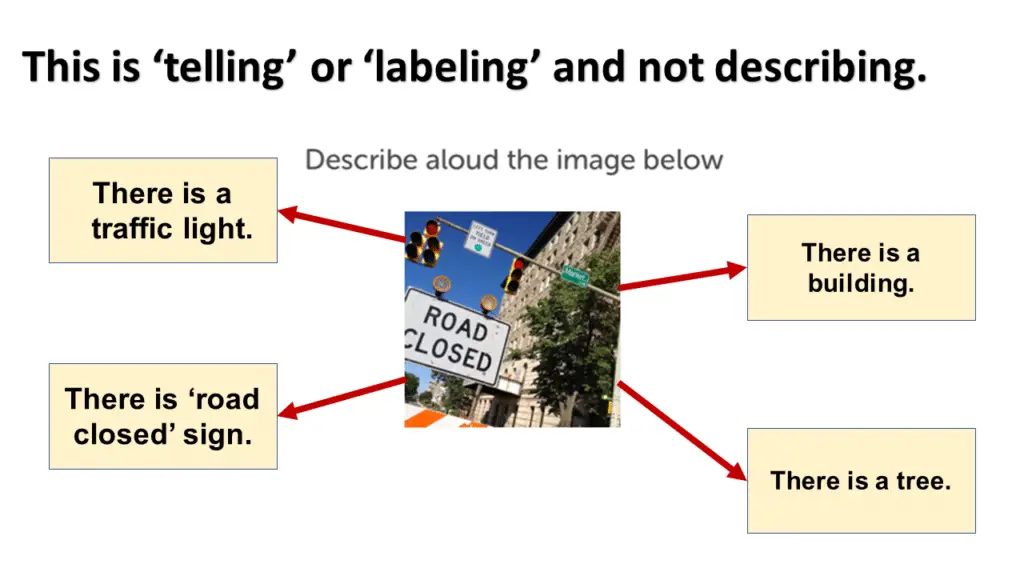
The image shows a fine day with a sign of a closed road downtown, and it seems that there is ongoing construction in the area. With the bright sunlight, I can tell that it must have been taken during the daytime, somewhere between 8 to 11 in the morning. By looking at the foreground, above the road sign is a traffic light in red, and having traffic lights in places like this, tells us that there must be a pedestrian crossing nearby. The building's architecture resembles a residential or an important government building on the right of the picture. If it is the latter, road-closed signs may give an impression that there is a meaningful event or a tragic incident. Or maybe, just a simple construction of paving the road. It must have created heavy traffic and inconvenience for commuters in situations like this, especially during rush hour.
How to Answer the “Speaking Sample” Question Type?
This part will help you in the ungraded section of the Duolingo English Test: Video Interview Sample
- This question will appear once.
- You have to describe the photo aloud for 90 seconds.
- You have at least 30 seconds to speak.
- Speak for as long as possible.
- You are scored based on your content, fluency, and pronunciation.
- It contributes to your production and conversation subscores.

Tips for Answering this Question Type
- Select the subject matter on which you believe you have the most to say.
- Ignore the timer since it may cause you to lose focus and become less clear in your thoughts and speech.
- Continue to speak until the NEXT button becomes orange, and if possible, continue to talk for an even more extended period. Before selecting NEXT to complete and submit your tape, think about how it will come to a logical end.
- Consider practicing speaking about a subject in English for 1-3 minutes before taking the exam so that you are comfortable with the duration.
- Keep in mind that the Duolingo English Test will deliver your Speaking Sample as a video clip, which means that the people who get your scores will be able to watch you as you respond to the questions.
- Since the system will share your speaking sample with the people receiving your findings, make sure your answer is relevant to your selected topic.
Sample Practice Questions for the Speaking Section of the DET
We have collated some topics that may help you in the Duolingo English test, according to the Duolingo English Test speaking question type. Practice these questions and time yourself based on any of the writing question types.
1. Speak about a Topic — Sample Questions
These questions are useful for practicing for Speak about a Topic and Video Interview Sample question types.
Sample Answer for this Question Type
Question:
“Describe an instance when you could not use your mobile phone”
Tips for creating a response:
- Where did it happen?
- Were there any people allowed to use a mobile phone?
- How did you feel about the incident?
- Why was it essential to use a mobile phone?
Example Answer: When I was younger, I remember going to a meeting with my closest friend to talk about the changes that might be done in our area. The use of mobile phones was initially permitted for everyone. Then a statement was issued that banned the use of mobile phones. This was followed by a period of confusion. Despite the fact that the meeting only lasted 40 minutes, I was in a bad mood since I needed to make an essential phone call to my mother. I had to inform her when I would be back home since I had some visitors waiting for me over at my parents' house.
Now that you have a framework to use, practice your responses for the following sample questions:
Question 1: “Talk about a challenge you encountered”.
Tips for creating a response:
- What was the challenge?
- When and where was the challenge?
- How did you overcome it?
- What made it unforgettable?
Question 2: “Describe you’re hometown”.
Tips for creating a response:
- What was it like to grow up in that community?
- Is it different now than it was when you were a kid?
- What about living there do you like the most?
- Do you believe you’ll be able to stay there as an adult?
Question 3: Talk about your free time.
Tips for creating a response:
- What activities do you love to do in your free time?
- How long have you been interested in these pastimes?
- Do you prefer to do these things by yourself or with others? (Why)?
- Do you think that people have enough free time on their hands?
Question 4: Talk about being on time for appointments
Tips for creating a response:
- Is it normal in your culture to be late?
- Are you prone to being late for appointments?
- What kind of reasons do you believe are acceptable for being late?
- When someone is late for a meeting with you, how do you react?
Question 5: Discuss magazines and newspapers
Tips for creating a response:
- Newspapers or magazines, which do you prefer to read?
- What kinds of tales do you like reading?
- Do you believe that reading a magazine or newspaper may aid in the learning of a language?
- Why do some individuals prefer magazines over newspapers, in your opinion?
Question 6: Talk about The Internet
Tips for creating a response:
- Is it permissible for children to use the Internet at school in your country?
- Do you believe the Internet helps study?
- Have you ever purchased over the Internet?
- Is there any risk in purchasing anything online?
Question 7: Talk about a situation when you were late.
Tips for creating a response:
- What were you late for?
- Why were you late?
- What happened because you were late?
- How did you feel about it?
Question 8: Describe an incident where someone apologized to you.
Tips for creating a response:
- Who was it?
- When was it?
- What did the person say?
- Why was this incident memorable to you?
Question 9: Discuss the importance of education.
Tips for creating a response:
- Do you think education is essential?
- What is your highest educational attainment?
- What is your belief in this statement: education is the key to wisdom?
- In your opinion, do you think that high school graduates should pursue a college degree?
Question 10: Talk about your experience during this pandemic.
Tips for creating a response:
- What is your situation?
- When did this happen?
- What were your thoughts and challenges?
- How did you overcome them?
Listen, then Speak — Sample Questions
These kinds of questions are open-ended, and there are no “right” answers in this case. Practice speaking for a minimum of 30 seconds and record yourself in doing so.
Questions: (Click and Play)
To access these questions you need to sign up for a free account on the Duolingo English Test website. You can either use your email address or login using Gmail.
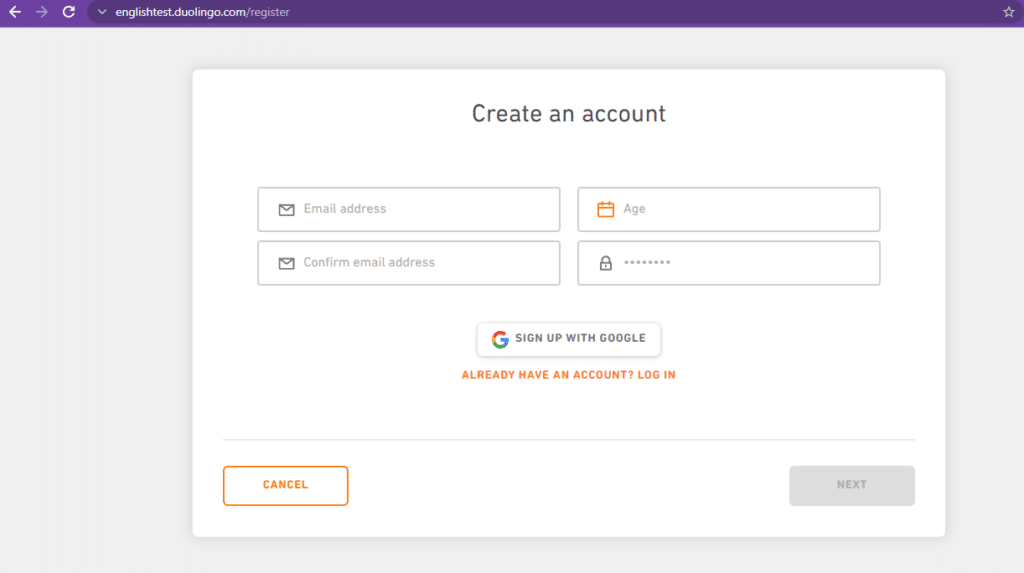
3. Describe a Photo Practice and Sample Responses
To practice, you can refer to the tips listed above to help you structure your ideas. As you practice, time and record yourself. Afterward, listen and check which areas you have to improve on.

Example Answer: In this picture, I can see a beach that extends for a kilometer or more with few people enjoying the warmth of the sun and is made up of fine, pure golden sand. Probably, it is taken in the morning with the sun shining brightly with a little overcast cloud. The heat of a scorching day is starting to scatter. On the far end in the background, there is a long bridge that stretches all the way to the waters. The beachgoers are already in a great position and continue to lie on their towels, some beneath their parasol umbrellas, to work on their tans, while others just sleep and read. Meanwhile, there are probably some local vendors selling their goods along the shore. From a high wooden tower at the beach's edge, one guy watches everything. He is the lifeguard, and he is constantly ready to perform an emergency rescue.
Now that you have a framework to use, practice your responses for the following sample questions:
Describe a Photo — Sample Exercise 2

4. Speaking Sample — Practice Questions
This ungraded portion of the test has no bearing on your final score. The receivers of your exam, on the other hand, will have access to your answers and will use them to learn more about you and your English language abilities. Here are a few samples or practice questions.
Question 1: Describe a story that you find interesting. This may be a book, a movie, a television program, or anything else that tells a narrative. What is it about the story that you like the most? What do you think might be done to make it better?
Question 2: Describe to us the geographical features of the country where you are presently located. How does the location of a country influence the people who live there and the culture they practice?
Question 3: Who is a person you think you have impacted in your life? What impact have you had on the person, and how?
Additional Tips for the Taking Duolingo English Test Speaking Section
If you’ve tried the Duolingo English Test practice, you know how important it is to study diligently to succeed. The following are some study suggestions that may be useful to you:
- Prepare all of your papers before the start of the exam, including:
- A legal identification document, such as a passport, driver’s license, or any other government-issued identification document
- A well-lit environment with minimal background noise is ideal.
- A computer having a front-facing camera, speakers, and microphone, as well as a browser that is compatible with it (Chrome, Opera)
- High-capacity internet access
- Read all of the regulations that the Duolingo Test Committee has set out.
- You are not permitted to use headphones or have anybody else in the room with you.
- The DET does not allow you to take any notes during the exam.
- Prepare yourself psychologically before taking the exam.
- Learn and practice new words. Look up new terms in the dictionary or write down unfamiliar words you hear or see in English.
- You never know what kind of questions you’ll get on the tests. As a result, try to study as many topics in English as possible.
- Make sure you demonstrate your vocabulary in the speaking sections. Make extensive use of synonyms and attempt to utilize a variety of sentence forms, including those that are more difficult.
- Don’t put too much pressure on yourself. Duolingo’s exam preparation resources are sufficient to ensure your success.
- Speak clearly and loudly and at a comprehensible speed.
- The system will not allow you to re-record your answer. So don’t worry if you make a mistake; simply go on.
- Keep in mind that you should not upload your recording until after you have completed the whole of your answer.
Additional FAQ About the Duolingo English Test
How Many Duolingo English Practice Tests Do I Need to Score Well?
To prepare for the Duolingo English Test, you must practice at least ten mock exams, which may be bought online or in the Duolingo English Test preparation books.
The mock exam has the same format as the Duolingo English Test, with questions assessing listening, speaking, writing, and reading abilities.
Are There Available Duolingo English Test Practice Papers for Free?
Likely, a full-length Duolingo English Exam practice test won’t be free. Although the exam may be shorter in length, it is still beneficial to understand the kind of questions asked in the original test.
For this, you may use the practice test on the Duolingo English Test website.
What Is the Level of Difficulty of Questions Asked in The Duolingo English Test – Video Interview?
The questions in the Duolingo English Test range from simple to moderate in complexity, with each question getting more challenging as candidates respond.
The Duolingo English Test will ask several questions in each area, such as listening, reading, writing, and speaking. Some questions may be challenging to answer, while others may be simple.
Since Practice Tests Are Limited, Which Books Should I Use to Study for The Duolingo English Test?
To prepare for the Duolingo English Test, you may get Ashok Kumar’s Duolingo English Test Book.
Aside from that, some general books may assist you in improving your English language abilities. Norman Lewis’ Word Power Made Easy, Sabina Pillai’s Spoken English for My World, Michelle Finlay’s Everyday English for Grown-Ups, and Saumya Sharma’s Common Errors in Everyday English are just a few of the books on the list.
Additional Reading — Duolingo English Test Test Guide
